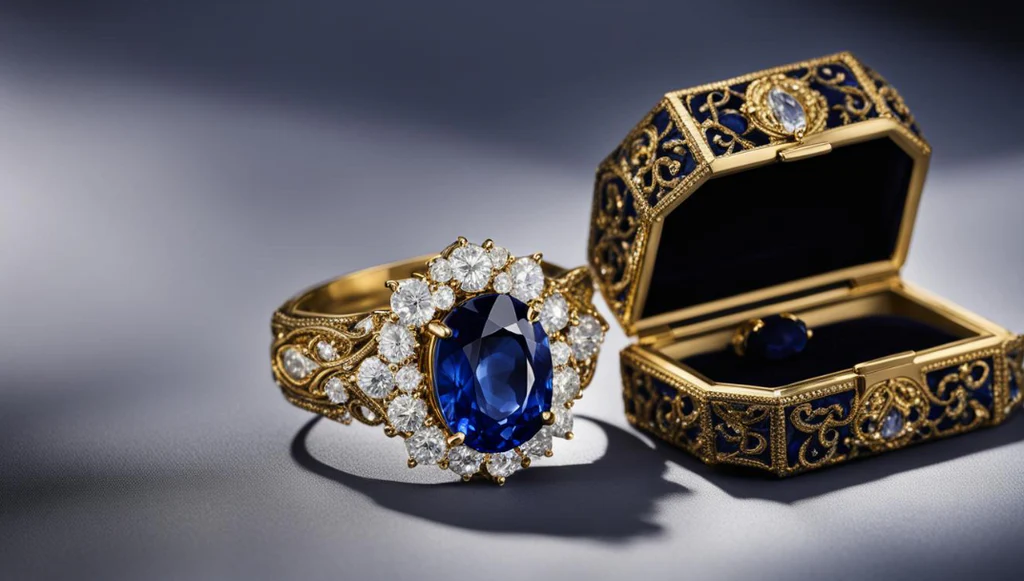Sapphire, renowned for its breathtaking beauty and remarkable durability, has captivated humanity for centuries. Often associated with royalty, wisdom, and celestial elegance, this precious gemstone continues to be a favorite choice for jewelry and a symbol of sophistication. This article delves into the fascinating world of sapphire, exploring its history, properties, and the reasons behind its enduring appeal.
The Rich History of Sapphire
The history of sapphire is as vibrant as the gemstone itself. Ancient civilizations revered sapphires, attributing mystical properties and divine connections to them. In ancient Persia, people believed that the sky was painted blue by the reflection of sapphires. The Greeks associated sapphires with Apollo, the god of prophecy, and wore them to seek his favor.
Sapphires have long been linked to royalty and nobility. Kings and queens adorned themselves with sapphire jewelry as a symbol of power and wisdom. One of the most famous sapphires is the engagement ring given to Lady Diana Spencer by Prince Charles, which now belongs to Catherine, Duchess of Cambridge. This royal connection has only added to the gemstone’s allure and prestige.
The Unique Properties of Sapphire
Sapphire belongs to the corundum family, which also includes ruby. Its remarkable hardness, second only to diamond, makes it an ideal choice for everyday wear in jewelry. While sapphires are most commonly known for their stunning blue hue, they come in a wide range of colors, including pink, yellow, green, and even colorless. These variations are known as “fancy sapphires” and are highly prized for their unique beauty.
The color of a sapphire is determined by trace elements present during its formation. For example, blue sapphires owe their color to the presence of iron and titanium, while pink sapphires contain traces of chromium. The most coveted blue sapphires come from Kashmir, Burma (Myanmar), and Sri Lanka, known for their exceptional color and clarity.
Symbolism and Meaning
Sapphires have been imbued with symbolic meanings throughout history. In addition to their royal associations, they are often linked to qualities such as wisdom, loyalty, and protection. Sapphires are believed to bring mental clarity, enhance intuition, and promote spiritual enlightenment. They are also thought to protect the wearer from negative energies and provide inner peace.
In ancient times, warriors wore sapphires into battle, believing that the gemstone would protect them from harm and ensure victory. Clergy members used sapphires to symbolize heaven, and the gemstone was often used in ecclesiastical rings and adornments.
Sapphire in Jewelry
Sapphire’s durability and range of colors make it a versatile choice for all types of jewelry, from rings and earrings to necklaces and bracelets. The gemstone’s deep blue hue, often referred to as “royal blue,” is particularly popular for engagement rings, symbolizing loyalty and devotion. The brilliance and elegance of sapphire make it a timeless choice for those seeking a gemstone that combines beauty with resilience.
When choosing a sapphire, several factors determine its value: color, clarity, cut, and carat weight. The most desirable sapphires exhibit a deep, vivid blue without any zoning (uneven color distribution). Clarity is also important, as inclusions can affect the gemstone’s transparency and brilliance. A well-cut sapphire will maximize its natural luster and sparkle, while carat weight influences the overall size and presence of the gemstone.
Ethical Considerations and Sourcing
As with all gemstones, ethical considerations are important when purchasing sapphires. Responsible sourcing practices ensure that the gemstones are mined and traded in a manner that respects both the environment and the communities involved. Many jewelers now offer sapphires that are certified to be conflict-free and ethically sourced.
Sri Lanka, known as the “Island of Gems,” has a long history of producing high-quality sapphires through sustainable mining practices. Madagascar and Australia are also significant sources of sapphires, each producing gemstones with unique characteristics.
Sapphire in Modern Culture
Beyond its historical and traditional significance, sapphire continues to hold a prominent place in modern culture. It is the birthstone for September, making sapphire jewelry a popular gift for those born in this month. Sapphires are also given to celebrate 45th wedding anniversaries, symbolizing enduring love and commitment.
In fashion, sapphire’s versatility and striking appearance have made it a favorite among designers and celebrities. The gemstone’s timeless appeal ensures that it remains a staple in both classic and contemporary jewelry collections.
Conclusion
Sapphire’s enduring appeal lies in its combination of beauty, durability, and rich symbolism. From ancient civilizations to modern royalty, this gemstone has been cherished and admired across cultures and generations. Whether set in an engagement ring, a pair of elegant earrings, or a statement necklace, sapphire continues to captivate with its celestial charm and regal elegance. As a symbol of wisdom, protection, and loyalty, sapphire remains a gemstone that transcends time, embodying the very essence of enduring beauty and sophistication.
